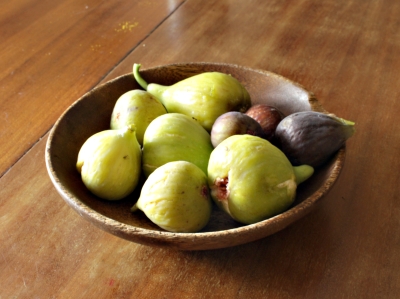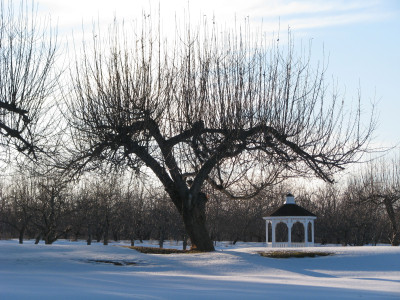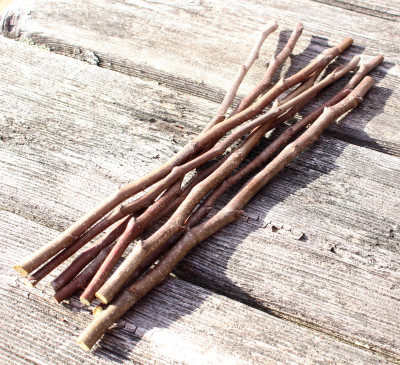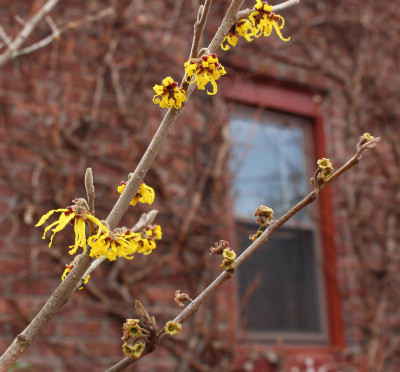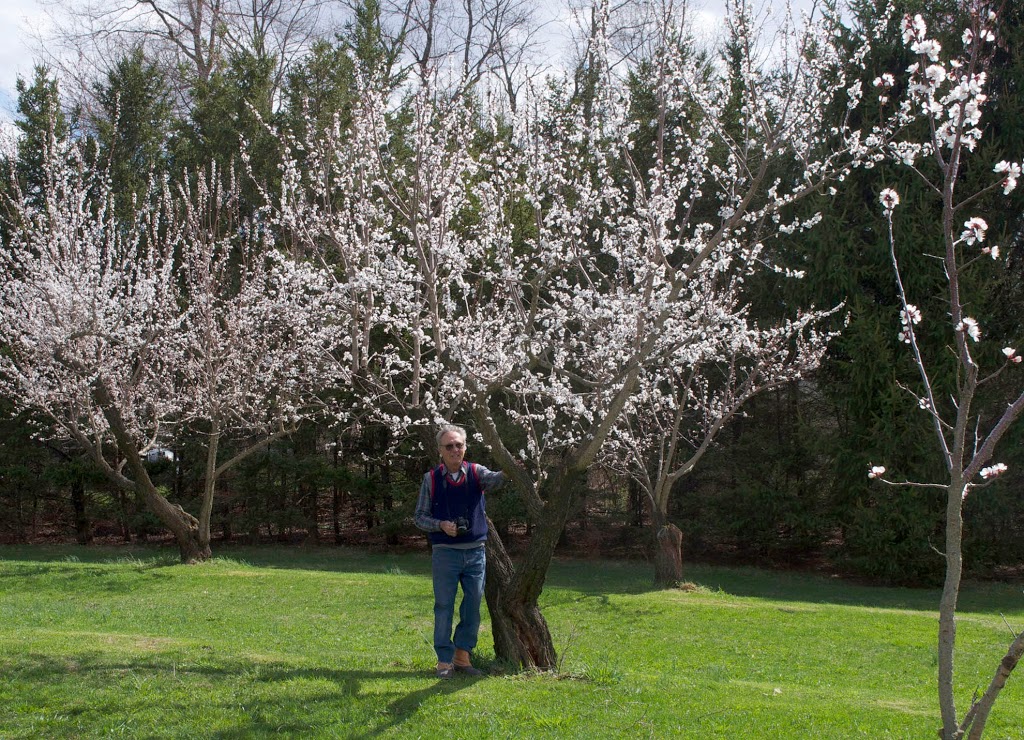FIGS: WAIT, DON’T GROW!
Stay Asleep Please
If you garden in a cold winter climate, as do I, I hope you’re growing figs. Despite being tropical plants, figs are relatively easy for us to grow, as attested to by other gardeners, from Moscow to Montreal, Minneapolis and beyond.

San Piero fig, ripe
If you garden in a cold winter climate, I also hope that your fig plant is NOT growing now (unless you’re in the Southern Hemisphere). The way we cold-climate fig growers help our plants face winter cold is by protecting them from it. A usual method is to grow a plant in a pot that gets moved to a sheltered location to wait out winter. (Growing in pots plus four other methods of overwintering figs are described in my recent book Growing Figs in Cold Climates.)
Sometimes — too often — a fig jumps the gun on spring and starts growing in its sheltered location. Figs shed their leaves when they feel cold is just around the corner, so don’t need bright light in winter. But once buds awaken, they need all the light it can get.
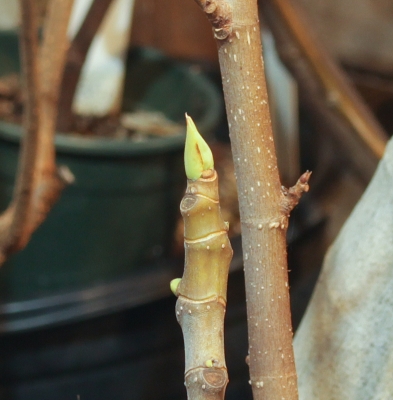
Fig starting to wake up
Don’t fool yourself that a sunny window is sufficient light. The light there typically ranges from 2,000 to 5,000 foot-candles, while full sunlight outdoors is over 10,000 foot-candles. With insufficient light, growth becomes etiolated, that is, stretched out and pale as if reaching for light. And when the time comes for the plant to move outdoors, strong sunlight and drying winds will burn those etiolated stems.
Sleep Recipes
So the goal is to retard growth until outdoor conditions are more fig-friendly. If fully dormant, the plant can tolerate temperatures down into the low 20s Fahrenheit, even colder in a large enough pot. (Cold penetrates more deeply into smaller pots, and fig roots, like those of all temperate-zone plants, can’t tolerate as much cold as stems.)
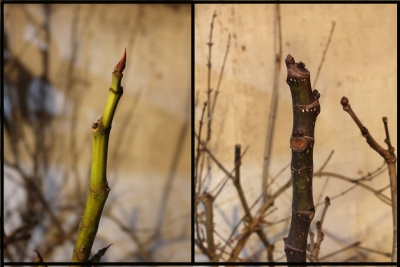
Fig stems, dormant
The ideal situation is to be able to move a fully dormant fig plant outdoors while temperatures are still cold, but not cold enough to injure the stems or roots. Then buds gradually unfurl in synch with warming temperatures and increasingly intense sunlight.
My potted plants are fully dormant, the result, all winter, of keeping the pots in a cold room with minimal watering. Ideal winter temperatures for a fig are between the high 20s and low 40s. A barely or unheated garage, a cold basement, an unheated mudroom or attic, perhaps even a shed can all keep a fig asleep long enough.
Most of my plants get watered just once in winter. I lift the pots and can tell by experience from their weight whether water is needed. A soil moisture meter probe also works. They are in humid locations, either in my basement or in a walk-in cooler. Sealing each pot and soil, not the stems, in a plastic bag could cut down or eliminate any need for water.
Only one of my potted figs has already started growing. (I let it do so for this photograph.) My one growing fig is actually doing quite well, with new growth expanding slowly and robustly. 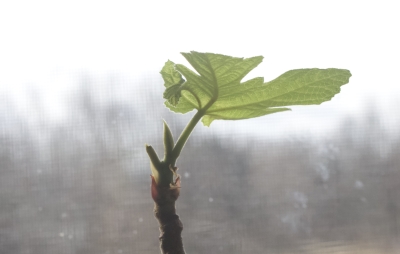 Besides having its thirst quenched just enough to prevent wilting, it sits in front of a large, unobstructed window facing due south in a room whose temperatures range from the 50s and 60s. (That’s why I’m writing while sitting here in a down jacket!)
Besides having its thirst quenched just enough to prevent wilting, it sits in front of a large, unobstructed window facing due south in a room whose temperatures range from the 50s and 60s. (That’s why I’m writing while sitting here in a down jacket!)
Shock Treatment
Okay, so you can’t provide ideal enough conditions, and your plant is overenthusiastic about winter’s end. Give it a little shock. Potted figs do need repotting every year or two to refresh soil nutrients and give roots new room to grow. If the plant is in as large a pot as you wish, the root ball needs to be slid out of the pots and sliced back to afford space for fresh potting soil. The larger the plant, the more roots can be removed. I go around the edge of the root ball with a kitchen knife slicing an inch or two off around the edge of the root ball. That should tell Ms. Fig to chillax!
The larger the plant, the more roots can be removed. I go around the edge of the root ball with a kitchen knife slicing an inch or two off around the edge of the root ball. That should tell Ms. Fig to chillax!
Stem pruning is another way to put the brakes on growth. And figs anyway benefit from annual pruning. How much to prune depends on the bearing habit of the fig, some varieties bearing best on new growth, some on one-year-old growth, and still others on both types of growth. (I refer you to my book for details about pruning figs.)
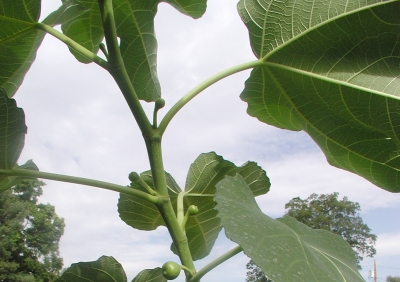
Fig fruits developing on new growth
Not to Worry
Perhaps you haven’t provided ideal winter conditions, you have no sun drenched windows, your home is warm, and you already repotted and pruned last fall. Don’t give up. Worst case scenario is that sappy, etiolated stems have emerged on your fig plant. Once outdoor temperatures moderate, you have three choices.
Gradually acclimate the plant to the great outdoors in much the same way as is done with tomato seedlings. Start the plant with a week or so in an outdoor location protected from full sunlight, wind, and freezing temperatures, moving it periodically indoors if conditions make it necessary. Gradually move it to the more exposed location of its summer home.
Second choice. Move the plant immediately to its summer home, but prune back growing stems, which, anyway, will likely burn.
Third, and easiest, choice, is to move the plant immediately to its summer home. Period. You’ll see some dieback and burning, but the plant should survive unless it’s very young or very weak.
The nice thing about growing figs, and one of the thinks that makes it possible to grow them in cold climates, is that they are very forgiving plants. More so than you might imagine.